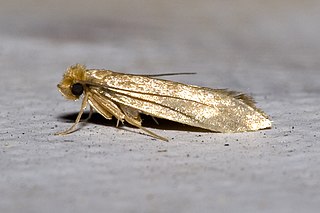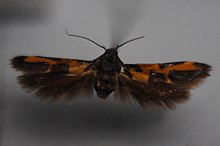
Manchester Museum is a museum displaying works of archaeology, anthropology and natural history and is owned by the University of Manchester, in England. Sited on Oxford Road (A34) at the heart of the university's group of neo-Gothic buildings, it provides access to about 4.5 million items from every continent. It is the UK's largest university museum and serves both as a major visitor attraction and as a resource for academic research and teaching. It has around 430,000 visitors each year.

John Curtis was an English entomologist and illustrator.
Albert Stewart Meek was an English bird collector and naturalist.

Tineola bisselliella, known as the common clothes moth, webbing clothes moth, or simply clothing moth, is a species of fungus moth. It is the type species of its genus Tineola and was first described by the Swedish entomologist Arvid David Hummel in 1823. The specific name is commonly misspelled biselliella – for example by G. A. W. Herrich-Schäffer, when he established Tineola in 1853.

The white-shouldered house moth is a species of gelechioid moth. It belongs to the subfamily Oecophorinae of the concealer moth family (Oecophoridae), just like the brown house moth. Though several presumed congeners of E. sarcitrella were described, its genus Endrosis is currently understood to be monotypic.

Kersal Moor is a recreation area in Kersal, Greater Manchester, England which consists of eight hectares of moorland bounded by Moor Lane, Heathlands Road, St. Paul's Churchyard and Singleton Brook.
Bucaea is a genus of tiger moths in the family Erebidae. The moths in the genus are found in Hindustan.
Lysceia is a monotypic moth genus in the subfamily Arctiinae described by Francis Walker in 1854. It contains a single species, Lysceia bigutta, described by the same author in the same book, which is found in South Africa.
Hapda is a monotypic moth genus of the family Erebidae described by Nye in 1975. It was first described by Francis Walker in 1863 as Dapha. Its only species, Hapda exhibens, was described by Walker in 1863.
Modunga is a monotypic moth genus of the family Erebidae. Its only species, Modunga palpigera, is known from Borneo. Both the genus and the species were first described by Francis Walker in 1863.

Euclemensia is a genus of moth in the family Cosmopterigidae.

Nemaxera is a genus of the fungus moth family, Tineidae. Therein, it belongs to the subfamily Nemapogoninae. The genus is considered monotypic, with the single species Nemaxera betulinella placed here.

Sabatinca incongruella is a species of moth of the family Micropterigidae. It is endemic to New Zealand and is found only in the northern parts of the South Island. It is a day flying moth and is on the wing from mid January until late February. The larvae of this species feed on liverworts and the adult moths feed on the spores of fern species in the genus Pneumatopteris. This species can be confused with S. chalcophanes as it is very similar in appearance.
Stigmella maoriella is a species of moth in the family Nepticulidae. It is endemic to New Zealand. It is classified as Not Threatened by the Department of Conservation.
Nannoarctia takanoi, described by Jinhaku Sonan in 1934, is an endemic species of moth in the family Erebidae from Taiwan. It is probably extinct now; no specimens have been collected since World War II. The species was formerly known as Pericallia integraMatsumura, 1931, but specimens from Taiwan are not conspecific to those from the Philippines, where N. integra(Walker, 1855) occur.
Lamacha is a monotypic genus of snout moths. It was described by Francis Walker in 1863 and contains the species Lamacha bilineolata. It is found in China.
Marisba is a monotypic snout moth genus. Its one species, Marisba undulifera, was described by Francis Walker in 1863, and is known from Brazil.

Euclemensia bassettella, the kermes scale moth, is a moth in the family Cosmopterigidae. It was described by James Brackenridge Clemens in 1864. It is found in North America in New Hampshire, southern Ontario, Illinois and from Florida to eastern Texas. The species lives on or near oak trees infected with scale insects.

Nistra is a genus of snout moths in the family Crambidae. It is monotypic, being represented by the single species Nistra coelatalis, which was formerly included in the genus Agrotera.
Pandala is a monotypic moth genus in the family Eupterotidae described by Francis Walker in 1855. Its single species, Pandala dolosa, described by the same author in the same year, is found in Sri Lanka.













